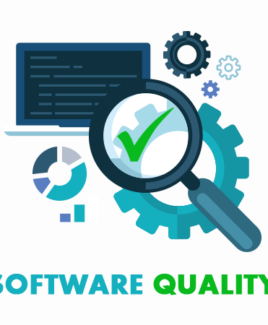Software quality is crucial for creating reliable, efficient, and user-friendly applications. Poor-quality software can lead to security vulnerabilities, performance issues, and customer dissatisfaction. Ensuring software quality involves a combination of best practices, methodologies, and tools throughout the software development lifecycle (SDLC). This guide provides an in-depth approach to building high-quality software, covering key principles, best practices, testing strategies, and continuous improvement techniques.
1. Understanding Software Quality
Software quality refers to the degree to which software meets customer requirements, functions correctly, and remains maintainable and scalable. The primary attributes of software quality include:
1.1 Key Attributes of Quality Software
- Functionality: The software meets the specified requirements and performs the intended tasks.
- Reliability: The software operates correctly under various conditions without failure.
- Usability: The software is user-friendly and intuitive.
- Performance Efficiency: The software runs smoothly, responds quickly, and utilizes resources optimally.
- Security: The software is protected against vulnerabilities, data breaches, and unauthorized access.
- Maintainability: The software is easy to update, modify, and debug.
- Scalability: The software can handle increased loads and evolving business needs.
2. Best Practices for High-Quality Software Development
2.1 Requirement Analysis and Planning
Before writing code, clear and well-defined requirements must be gathered. This step includes:
- Conducting stakeholder interviews to understand expectations.
- Writing clear and concise requirements documentation.
- Using tools like Jira, Trello, or Confluence for project tracking.
2.2 Following Software Development Methodologies
Choosing the right development methodology enhances software quality:
- Agile: Encourages iterative development, continuous feedback, and flexibility.
- DevOps: Integrates development and operations teams for continuous deployment and monitoring.
- Waterfall: A structured approach where each phase must be completed before the next begins.
2.3 Version Control and Collaboration
Using a version control system like Git ensures:
- Code tracking: Allows rollback to previous versions if issues arise.
- Branching strategies: Manages feature development and bug fixes efficiently.
- Collaborative development: Enables multiple developers to work simultaneously without conflicts.
3. Writing High-Quality Code
3.1 Code Standards and Best Practices
- Follow coding guidelines: Maintain consistency in formatting, naming conventions, and indentation.
- Use meaningful variable names: Enhance code readability and maintainability.
- Write modular code: Break down functionality into small, reusable components.
- Avoid code duplication: Implement the DRY (Don’t Repeat Yourself) principle.
- Document the code: Use comments and README files for better understanding.
3.2 Code Review and Pair Programming
Code reviews help in detecting errors early and improving code quality. Best practices include:
- Conducting peer reviews: Developers review each other’s code for errors and improvements.
- Using code review tools: Tools like GitHub, Bitbucket, and Crucible facilitate structured reviews.
- Pair programming: Two developers collaborate in real-time to enhance code quality.
4. Software Testing Strategies
4.1 Unit Testing
- Verifies individual components of the software.
- Tools: JUnit, NUnit, Mocha, Jest.
4.2 Integration Testing
- Ensures different modules work together correctly.
- Tools: Selenium, TestNG, Postman (for API testing).
4.3 Functional Testing
- Validates that software functions as expected.
- Techniques: Black-box testing, white-box testing.
4.4 Performance Testing
- Assesses speed, responsiveness, and stability.
- Tools: JMeter, Gatling, LoadRunner.
4.5 Security Testing
- Identifies security vulnerabilities and ensures data protection.
- Tools: OWASP ZAP, Burp Suite, SonarQube.
4.6 User Acceptance Testing (UAT)
- Ensures the software meets end-user requirements.
- Involves real users testing the system before final deployment.
4.7 Automated Testing
- Reduces manual effort and increases test coverage.
- Tools: Selenium, Cypress, Appium.
5. Continuous Integration and Deployment (CI/CD)
5.1 Importance of CI/CD
- Automates build, testing, and deployment processes.
- Reduces integration issues and accelerates releases.
5.2 Implementing CI/CD Pipelines
- Continuous Integration (CI): Automatically tests and integrates new code changes.
- Continuous Deployment (CD): Automates the release of new features.
- Tools: Jenkins, GitHub Actions, GitLab CI, Travis CI.
6. Monitoring and Maintenance
6.1 Monitoring Tools
- Log management: ELK Stack (Elasticsearch, Logstash, Kibana), Splunk.
- Application performance monitoring (APM): New Relic, Datadog, Prometheus.
- Error tracking: Sentry, Rollbar.
6.2 Handling Bugs and Updates
- Maintain a structured bug-tracking system (e.g., Jira, Bugzilla).
- Implement automated regression testing to catch new bugs early.
- Prioritize software updates to improve functionality and security.
7. Security Best Practices
7.1 Secure Coding Standards
- Avoid hardcoding credentials.
- Use parameterized queries to prevent SQL injection.
- Implement input validation to prevent XSS and CSRF attacks.
7.2 Data Encryption
- Use HTTPS (SSL/TLS) for secure data transmission.
- Encrypt sensitive data at rest and in transit.
7.3 Access Control
- Implement role-based access control (RBAC).
- Use multi-factor authentication (MFA) for sensitive operations.
8. Documentation and Knowledge Sharing
8.1 Importance of Documentation
- Facilitates onboarding of new team members.
- Ensures consistency in development practices.
- Provides clarity for future modifications.
8.2 Types of Documentation
- Technical Documentation: Covers system architecture, API references.
- User Manuals: Helps end-users navigate the software.
- Test Cases and Reports: Tracks testing results and issues.
8.3 Knowledge Sharing Practices
- Conduct regular team meetings and code walkthroughs.
- Use platforms like Confluence, Google Docs for collaborative documentation.
9. Continuous Improvement and Feedback Loops
9.1 Gathering User Feedback
- Implement feedback mechanisms via surveys, reviews, and analytics.
- Use heatmaps (Hotjar, Crazy Egg) to analyze user behavior.
9.2 Agile Retrospectives
- Hold sprint retrospectives to discuss improvements.
- Encourage team collaboration to optimize workflows.
9.3 Adapting to New Technologies
- Stay updated with the latest programming languages, frameworks, and tools.
- Participate in developer communities and conferences.
10. Conclusion
Creating quality software is a continuous process that requires a combination of best practices, rigorous testing, security measures, and continuous improvement. By implementing structured workflows, automating testing, monitoring system performance, and prioritizing security, teams can build scalable, maintainable, and high-performing applications.
Ensuring software quality is not a one-time task but an ongoing commitment. With the right strategies and tools in place, organizations can consistently deliver software that meets user expectations and stands the test of time.
